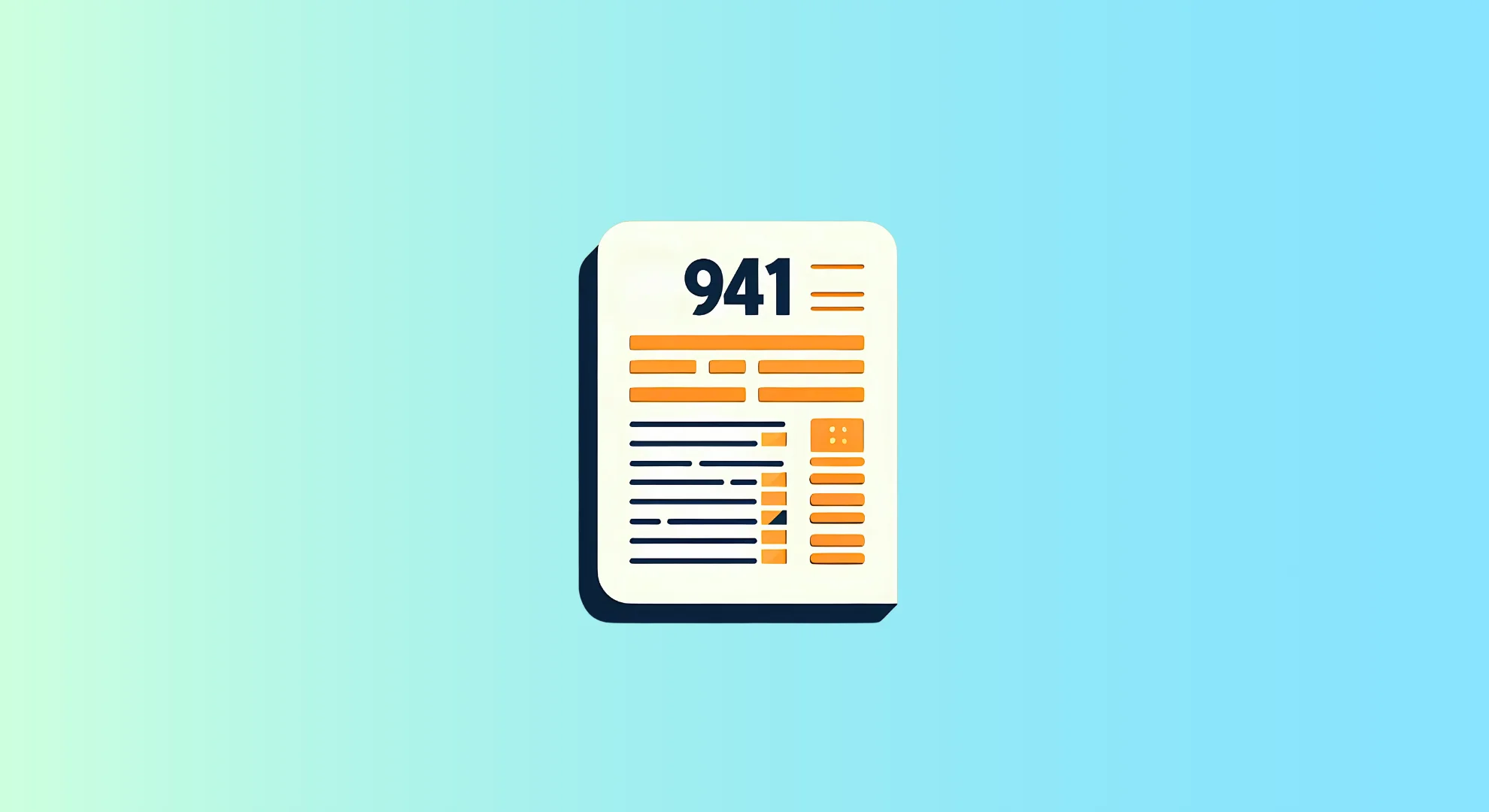Have you ever felt like navigating the world of payroll taxes is a complex dance? If you’re an employer, you’ve likely encountered Form 941, the Employer’s Quarterly Federal Tax Return. Don’t worry. We’re here to break it down for you! This guide will equip you with everything you need to understand, complete confidently, and file Form 941.
Table of Contents
What is a 941 Federal Tax Form?
Form 941, officially titled the Employer’s Quarterly Federal Tax Return, is a document businesses use to report and pay federal payroll taxes withheld from their employees’ wages. These taxes typically include:
- Federal income tax: The portion of an employee’s income withheld by the employer and sent to the IRS.
- Social Security tax: Funds the Social Security program, providing benefits to retirees and disabled individuals.
- Medicare tax: Supports the Medicare program, offering healthcare coverage to seniors.
Think of it this way: When you withhold these taxes from your employee’s paychecks, you’re essentially holding onto that money on behalf of the IRS. Form 941 allows you to report the total amount withheld and send it to the IRS, ensuring your employees’ tax obligations are met.
Uses of Federal Tax Form 941
The primary purpose of Form 941 is twofold:
- Report Withheld Taxes: As mentioned earlier, you use Form 941 to report the total amount of federal income tax, Social Security tax, and Medicare tax withheld from your employee’s wages throughout the quarter.
- Pay Employer Taxes: In addition to reporting withheld employee taxes, Form 941 allows you to calculate and pay your portion of Social Security and Medicare taxes, typically 1.45% for Medicare and 6.2% for Social Security (as of tax year 2024). These employer contributions fund the same programs as the employee-withheld taxes.
When to file Federal Tax Form 941?
Form 941 operates on a quarterly schedule. This means you’re required to file a return for each quarter of the calendar year with the following deadlines:
| Quarter | Due Date |
| 1st Quarter (January – March) | April 30th |
| 2nd Quarter April – June) | July 31st |
| 3rd Quarter (July – September) | October 31st |
| 4th Quarter (October – December) | January 31st of the following year |
Important Note: The deadline typically shifts to the next business day if the due date falls on a weekend or holiday.
Missing a deadline can result in penalties, so keeping track of these dates is crucial. Consider setting calendar reminders or utilizing accounting software to automate these deadlines.

What’s the difference between Federal Tax Form 940 and 941?
There needs to be some clarification between Form 940 and Form 941. Let’s clear things up:
- Form 940: The Employer’s Annual Federal Unemployment (FUTA) Tax Return is used to report and pay federal unemployment taxes. It’s filed annually, typically by January 31st of the following year.
- Form 941: As discussed previously, this form is used to report and pay federal income tax, Social Security tax, and Medicare tax withheld from employees, along with your employer tax contributions. It’s filed quarterly.
In essence, Form 940 deals with unemployment taxes, whereas Form 941 focuses on income and payroll taxes.
Where to file Form 941?
There are two primary ways to file Form 941:
- Electronically: The IRS strongly encourages electronic filing, which is faster, more secure, and less prone to errors. You can file electronically through the IRS website’s “IRS e-file” system or utilize authorized tax software programs that offer electronic filing options.
- Paper Filing: While traditional paper filing is still accepted, it’s generally slower and may be more susceptible to processing delays. You can download Form 941 from the IRS website and mail it to your designated address based on your location.
It’s important to consult the IRS instructions for Form 941 to determine the specific filing address for your location.
How often must employers file Federal Tax Form 941?
As mentioned earlier, Form 941 is filed quarterly. This means you’ll need to complete and submit a separate Form 941 for each quarter of the calendar year, adhering to the deadlines mentioned previously.
However, there are some exceptions to the quarterly filing requirement. Here’s a breakdown:
- Monthly Filers: If your business withheld more than $50,000 in total federal payroll taxes (income tax, Social Security, and Medicare) during the lookback period (the prior four quarters), you’re considered a monthly depositor. You must deposit these taxes electronically throughout the month rather than waiting for the quarterly deadline. However, you’ll still file Form 941 quarterly to report the total withheld and deposited taxes.
- New Businesses: If your business is brand new and needs to complete a full quarter of operations, you’re not required to file Form 941 for that initial partial quarter. Your filing requirement begins the following quarter when you have a full quarter’s worth of payroll data to report.
Seeking Help with Form 941
While Form 941 can be completed independently, navigating payroll taxes can be complex, especially for businesses with many employees or intricate tax situations. Here are some options to consider:
- Payroll Software: Many programs offer built-in functionalities for calculating, withholding, and depositing payroll taxes. These programs can simplify the Form 941 filing process by automatically generating the necessary data and potentially integrating it with electronic filing options.
- Tax Professional: Consulting with a qualified tax professional can provide invaluable guidance, especially when dealing with complex tax scenarios or potential tax credits. They can assist with completing Form 941 accurately and ensure you’re meeting all your federal

Conclusion
By understanding the purpose, requirements, and filing process for Form 941, you can ensure your business complies with federal payroll tax regulations. Remember, accurate and timely filing helps avoid penalties and keeps your business in good standing with the IRS. Utilize the resources available, and consider seeking professional guidance when needed to navigate the world of payroll taxes confidently.










